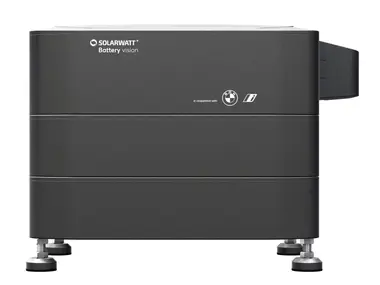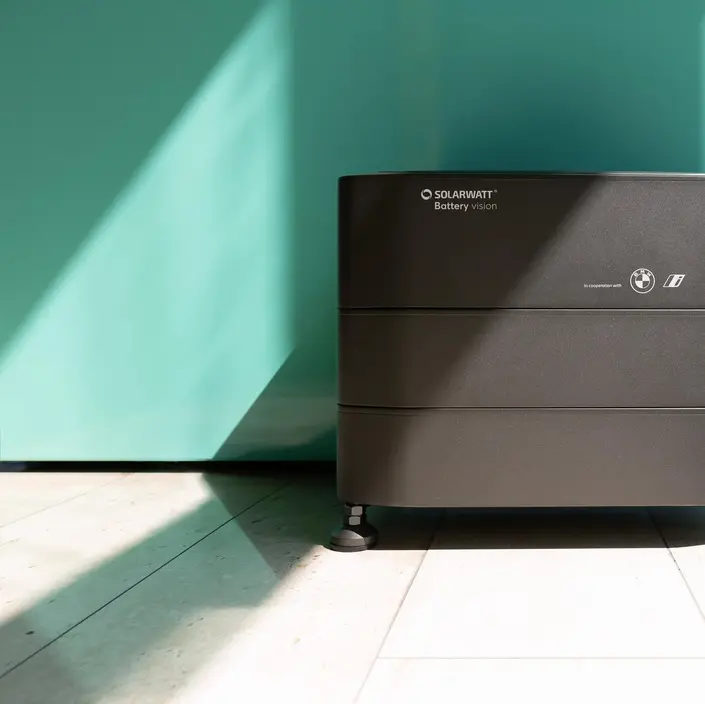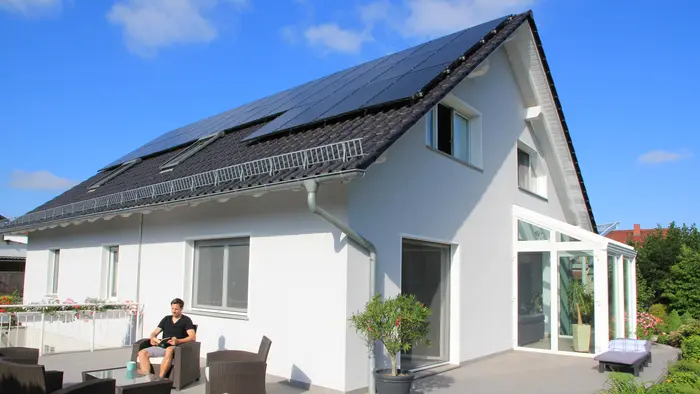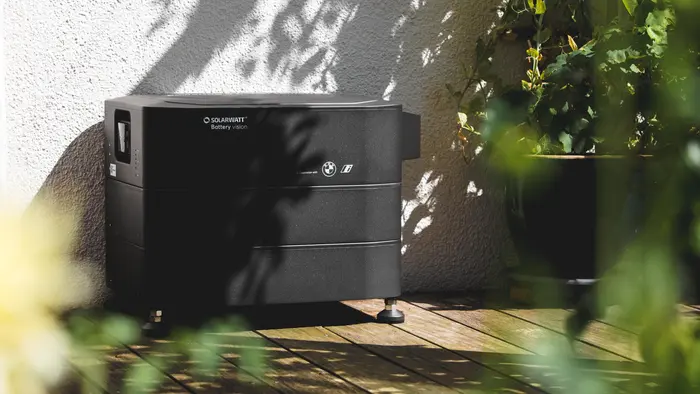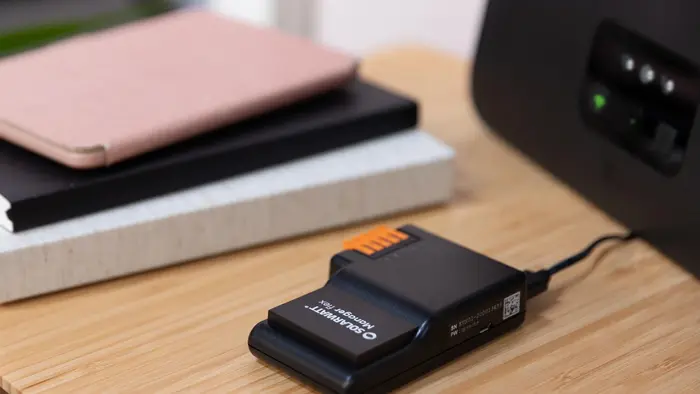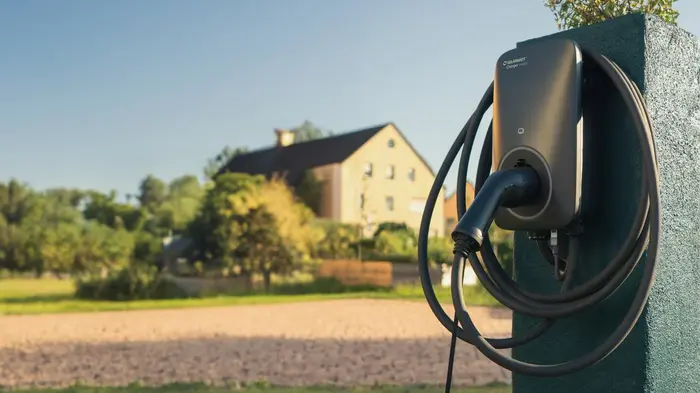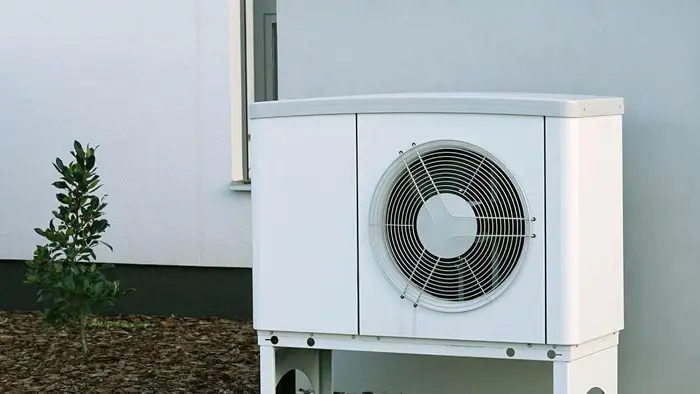Home battery system
Use photovoltaic power at night too
The issue of saving electricity is becoming increasingly important as part of the energy transition. Solar and wind energy are volatile, i.e. the generation of energy fluctuates. There are already various types of technologies that can help save surplus electricity on a large and small scale.
These range from pumped storage plants to fuel cells, lithium-nickel-manganese-cobalt batteries or lithium-iron-phosphate storage, saltwater batteries and much more.
However, the total storage capacity is not yet sufficient to supply us with electricity and stabilise the grid in the long term if we do without nuclear power and coal-fired power. We can expect to see a significant acceleration in development here over the next few years.
Solar storage for households and businesses
When people talk about home battery systems in connection with photovoltaics, they are generally referring to battery storage systems and, in rare cases, so-called redox flow storage systems. The latter are mainly used in research.
Technologies for household battery storage have primarily converged around lithium-ion and to a lesser extent, lead-ion batteries. In the home, storage systems enable homeowners to increase their self-consumption by storing excess solar power generated during the day for use at night; to avoid having to pay to import electricity from the grid during hours when the panels aren't generating anything. On a larger scale, however, battery storage systems are also used for electricity market trading and on a utility-scale to stabilise the local power grid.
What are the benefits of a home battery system?
Photovoltaic systems produce solar power that must be used immediately without a battery. This is rarely effective, as the electricity is mainly generated during the day. During these hours, however, most households have a low electricity demand.
Generally speaking, electricity demand in the home increases significantly in the evening, as power is used for cooking and devices are switched on as people return from work. With a battery, you can use the solar power you don't need during the day when during these hours when you actually really need it. Without having to change your habits, you can achieve:
- cost savings, thanks to a sustainable reduction in your electricity bill,
- Your personal contribution to the energy transition and the optimisation of your own consumption, as well as
- increasing your self-sufficiency from the energy supplier.
Increasing demand for battery storage systems
For operators of private photovoltaic systems, it is nowcheaper to consume solar power themselves than to feed it into the public grid and receive the feed-in tariff. This has been below the electricity price since 2011.
It now accounts for less than a third of the cost of grid electricity. As a result, the demand for battery storage systems in particular has increased significantly.
Ecological advantages of self-consumption with solar storage systems
In addition, the devices not only save electricity costs, they also significantly improve your own ecological footprint. EUPD Research has determined that CO2 savings can be almost doubled with the help of a solar storage system.
While a PV plant without a battery saves around 45%, the reduction for a system with a home storage unit is up to 85% compared to pure grid consumption.
Photovoltaic storage systems are in vogue
The demand for home battery systems for private use has increased significantly in recent years, as the installation figures show. According to the market research institute EUPD Research, around 78,500 new photovoltaic home storage systems were installed in 2019, compared to 37,500 solar storage systems two years earlier. This corresponds to an almost doubling of the market.
In the first half of 2020, 46,000 new installations were already recorded. In 2022, the number even rose to almost 630,000 solar storage systems in German households. in 2023, the photovoltaic storage industry experienced another significant upswing, with an increase in installed photovoltaic batteries to almost 1.2 million, of which over 570,000 were newly installed.
These meters illustrate the continuing trend towards the use of photovoltaic batteries. The main reasons for this trend are the desire for lower electricity bills and self-sufficiency as well as the significantly falling costs for higher storage capacity.
Reduce electricity costs

Reduce electricity costs
By using a solar storage system, more of the self-produced solar power can be consumed. The electricity does not have to be fed into the grid to be purchased at a later date. The increased self-consumption significantly reduces electricity costs.
How home battery systems work
The purpose of home battery systems is clear: they make self-generated solar power available exactly when it is needed - usually in the evening and at night. The principle behind this is as follows:
The electricity generated in a photovoltaic system is initially used for self-consumption. This means that active electricity consumers, such as freezers or other household appliances, are operated with the electricity.
However, if more electricity is available than required, the surplus solar power flows into the battery of the storage system and this is charged.
Role of the home battery system with fluctuating consumption
If there is a higher demand for electricity in the evening or at night, the battery provides the stored solar power. If the demand for electricity during the day is higher than the amount of solar power produced by the photovoltaic system, stored electricity is also used - regardless of whether the battery is fully or only partially charged.
Only when the stored solar power is no longer sufficient is further electricity drawn from the grid by the energy supplier. In this way, it is possible to cover a large part of the required amount of electricity with the solar power generated by the photovoltaic system.
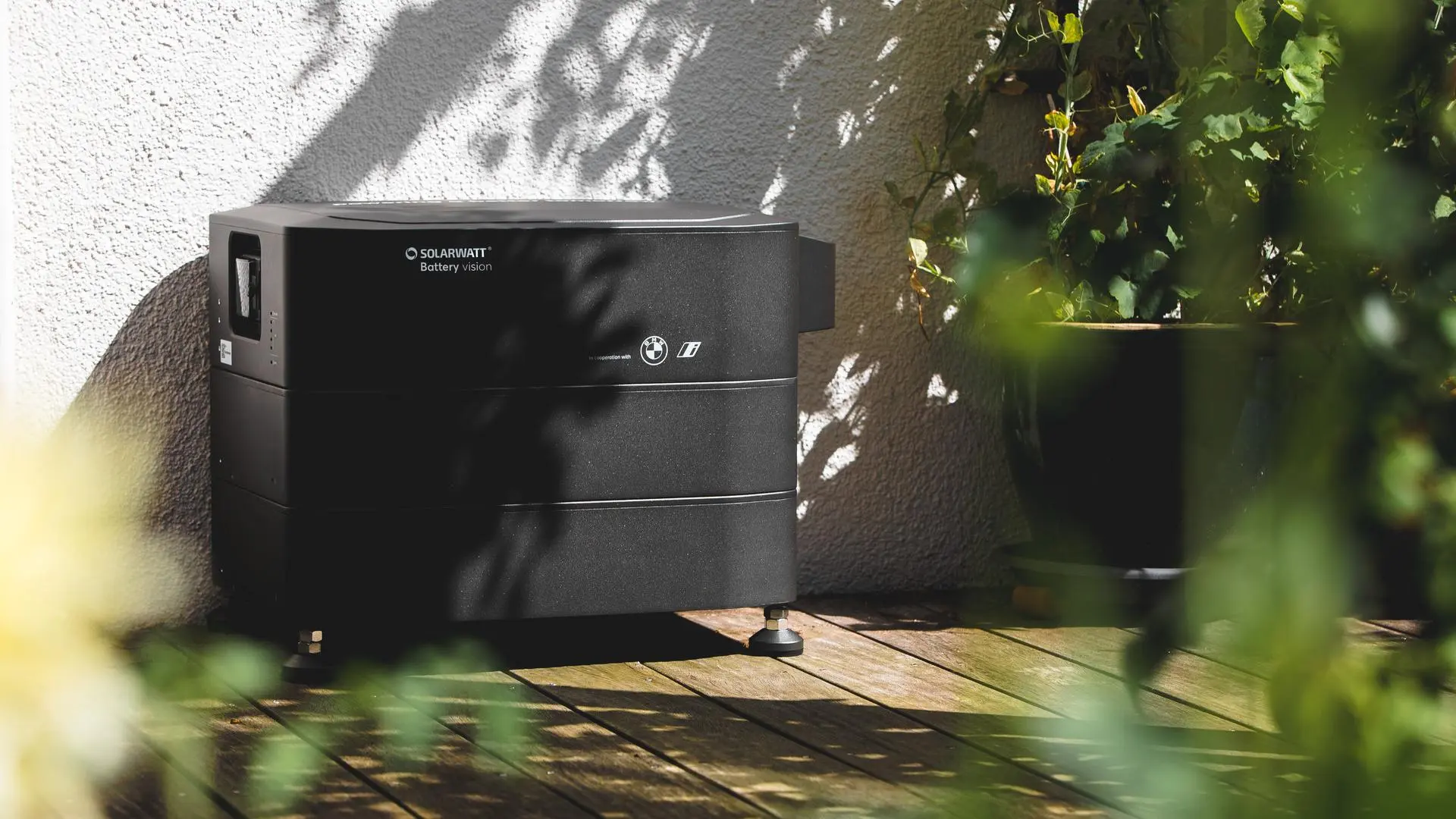
Structure of a home battery system
Solar batteries generally do not consist of a single battery cell, but of a large number of cells that are interconnected. In order for the battery to work smoothly, it requires a Battery management system (BMS) that monitors the individual cells and ensures a uniform charge level.
If individual battery cells threaten to overheat, the BMS switches off the home battery system. It also determines the charging strategy of the battery, i.e. how quickly charging and discharging takes place and which currents are realised.
What capacity should the home battery system have?
The central question that arises when purchasing a home battery system is its size or capacity. On the one hand, a battery that is too small should not "give away" any self-generated electricity. On the other hand, any additional capacity causes additional costs. This means that the size of the home battery system should be optimally adapted to the needs of the user.
There is an essential difference between the need to consume as much of the self-generated solar power as possible (high self-consumption rate) and as much self-sufficiency from the grid as possible (degree of self-sufficiency).
Observe requirements and restrictions
A prerequisite for the sensible use of the home battery system is always that sufficient surpluses are produced by the solar system to be able to charge the battery. Typically, the self-consumption rate without a battery is 25 to 40 %, i.e. a maximum of 60 to 75 % of the energy generated can be saved.
With a 10 kWp system, this amounts to approx. 7,000 kWh per year or approx. 20 kWh per day - enough energy to fill the solar storage system. Of course, it should not be forgotten that solar yields are significantly lower in winter than in summer.
If the focus is on complete self-sufficiency, the battery must have enough capacity to supply the household even if the solar power yield is very low for two or three days.
If the daily electricity requirement is around 14 kWh (approx. 5,000 kWh per year), the battery must have a capacity of 28 to 42 kWh. The investment costs required for this are enormous. In addition, large surpluses are required to be able to fully charge the battery - which is not always the case, especially in winter.
Weighing up the investment costs and benefits
It makes more economic sense to consume as much of the self-generated energy as possible on site. If the home battery system is designed with optimum self-consumption in mind, i.e. for self-sufficiency levels between 50 and 80 %, around 1 kWh (kilowatt hour) of storage capacity is required per kilowatt peak output of the photovoltaic system.
On average, photovoltaic batteries now have a size of 8.8 kWh; in private homes, batteries with capacities between 5 and 15 kWh are usually installed. However, the exact dimensioning should be carried out by an experienced installer.
Please note
The demand for electricity can change over time, for example due to the purchase of an electric car. It therefore makes sense if the battery storage system can be expanded at any time. Modular systems have proven themselves in practice for this purpose.
How can I integrate the solar storage system into the PV plants?
Some of the home battery systems available on the market - the DC-integrated solar storage systems - cannot be easily integrated into existing systems. In most cases, technical changes are necessary, such as replacing the inverter, which must be large enough for the PV plants and home battery system.
With AC-side integration, such a replacement is usually not necessary. While AC batteries are therefore particularly recommended for retrofitting, DC batteries are the method of choice for the construction of a new complete system.
Selection criteria for home battery systems in the private sector
There is a wide range of home battery systems available, but not all of them are suitable for use in the private sector: high weight and sometimes enormous dimensions limit the storage options of many energy storage systems for electricity and entail a great deal of installation work. It usually takes several installers at least one day.
DC-side installation
The device is installed between the PV plants and the inverter and the direct current from the plant can be saved directly. The conversion into the required alternating current only takes place when it is fed into the domestic electric circuits. This minimizes conversion losses and achieves a higher overall efficiency during charging and discharging.
Disadvantages of DC-side installation
- The battery must be adapted to the output of the system, which is why it tends to be more suitable for new systems
- The output of the PV inverter limits the output of the system and battery, as the inverter has to serve both sides
- Manufacturer must certify many inverter-solar storage combinations, which causes additional costs and affects the price
AC-side installation
The solar battery is integrated after the inverter and must therefore first convert the alternating current back into direct current using an internal inverter before saving. This slightly reduces the efficiency of these devices.
Advantages of AC-side installation
- Offers great flexibility, as it is independent of the output of the PV plants and the PV inverter
- Enables any storage capacity, making it particularly interesting for retrofitting existing systems.
- Useful for taking advantage of favourable grid electricity tariffs, as they easily save grid electricity
There is a lot to consider when installing a PV battery. Therefore, play it safe and always have a photovoltaic storage system installed by a certified specialist.
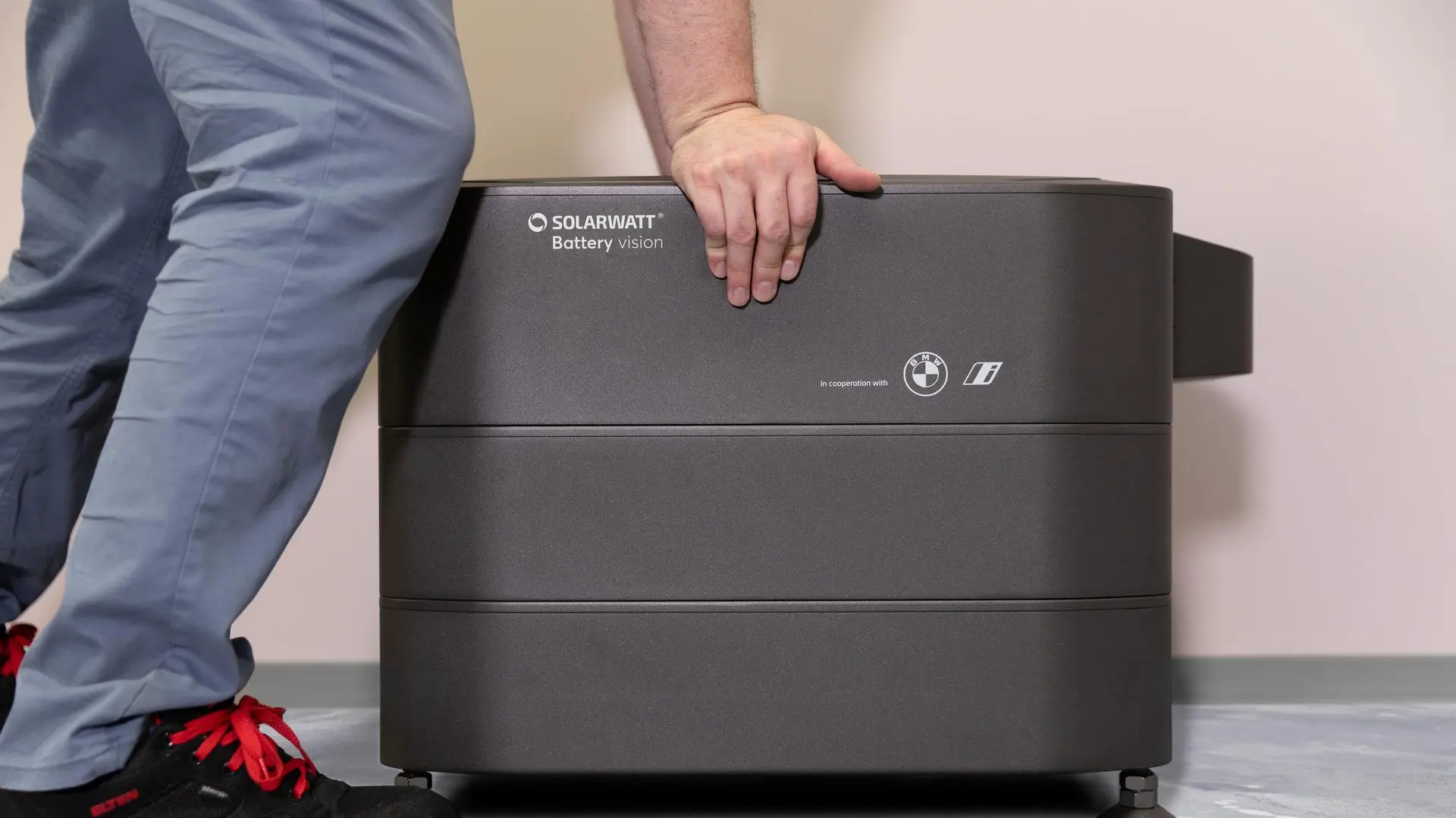
For whom is a photovoltaic storage system worthwhile?
When buying a new photovoltaic system, investing in a home battery system is particularly worthwhile if self-sufficiency is important to you. The battery allows you to consume a large proportion of the solar power yourself (high self-consumption). This significantly reduces the amount of electricity you purchase from the energy supplier.
Optimizing the profitability of self-consumption
At present, a kilowatt hour of electricity from the public grid costs around 29 pence for new contracts and around 34 pence for existing customers. Self-produced solar power costs around10 cents per kilowatt hour. These "production costs" are calculated from the costs of the solar system and the yield over the entire years in which the system is used.
The large difference in price makes it profitable to save surplus solar power and consume it yourself later. This is referred to as optimising self-consumption.
What to bear in mind
When deciding on a battery, please also consider future developments such as increasing electricity demand in the course of sector coupling.
The output of newly installed private photovoltaic systems is increasing, as heating and cooling as well as mobility are increasingly being electrified. Saving surplus solar power is therefore becoming increasingly worthwhile.
The price variety of home battery systems: A decision-making aid
Storage costs range between approx. 5,000 and 30,000 euros. The price depends, among other things, on the storage capacity, whether lithium-ion or lead batteries are used and which components are installed.
Due to the wide price range, it is advisable to take a close look at the technical data and key figures of home battery systems and weigh up what is important to you. Based on this information, you can narrow down the list of suitable photovoltaic batteries and then compare the costs.
Please note: Most prices are net prices (i.e. plus VAT). The costs for installation must also be added.
Use storage subsidies, reduce costs
Before buying a storage system, you should find out about the options for Home battery system subsidies before you buy.
0% VAT on home battery storage systems
As of 1 February 2024, the UK government has removed the VAT charge for domestic battery energy storage systems (BESS) under any circumstance. The Value Added Tax (Installation of Energy-Saving Materials) Order 2024 applies to BESS which are retrofitted to an existing installation and will continue to include them until 31 March 2027. Policy changes can occur at any time and Solarwatt will endeavour to update information for customers accordingly.
Use valuable solar power yourself
With a battery for photovoltaics, you can always use the solar power from your solar system when you really need it. This reduces your electricity bill in the long term.
Sophisticated technology, a long service life and a favorable price make PV storage systems an interesting option - both for new and existing solar systems. If you have any questions about this topic or about our home battery system, we will be happy to help you.
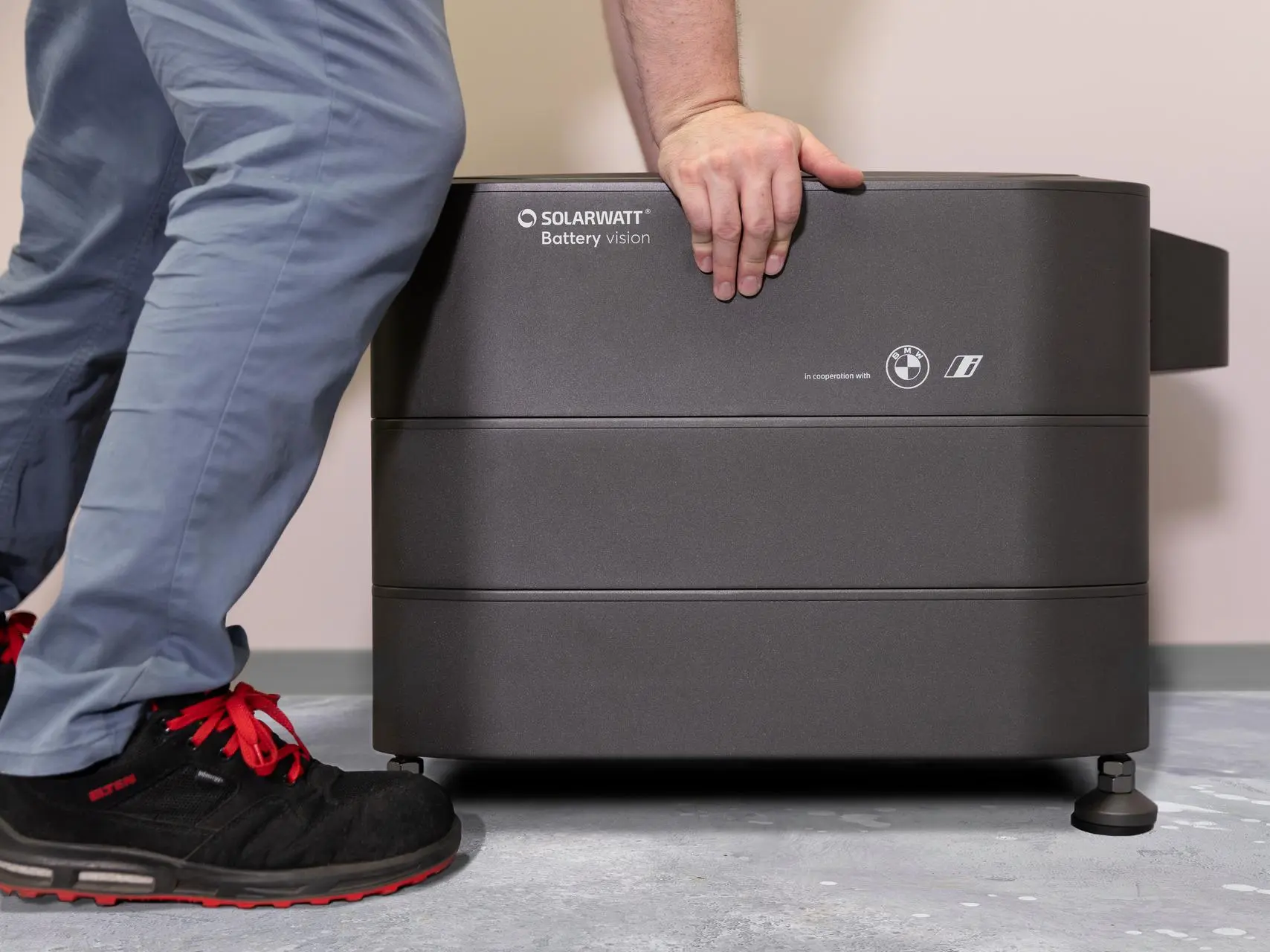
Finding the suitable photovoltaic battery
Lead-acid or lithium-ion battery - a fundamental decision
Solar storage systems for private use are either lead-acid, lead-gel or lithium-ion batteries. Lead-acid batteries were the most widely used in the past, for example as car batteries. However, lithium-ion batteries are increasingly gaining ground over lead-acid batteries due to their clear advantages:
- Lithium-ion batteries are expected to last around 15 years, while lead-acid batteries last between 5 and max. 10 years.
- Lithium-ion batteries achieve a depth of discharge of up to 100 %. Lead-acid batteries, on the other hand, can usually only be discharged to 50%, as a deeper discharge has a negative effect on the operating time.
- Lithium-ion batteries achieve a system efficiency of over 90 %, with lead batteries around 70 % is possible. Photovoltaic systems with lead batteries must therefore be larger, which results in unnecessary additional costs.
Once you have made the fundamental decision between a lithium-ion or lead-acid battery, various parameters play a key role in selecting the right solar storage system.
Parameters for the selection of the home battery system
The storage size or storage capacity is adapted to the respective requirements. Basically, the battery should be large enough to supply a household with solar power from the evening until the next morning.
For an average four-person household with an annual electricity consumption of approx. 4,500 kilowatt hours (kWh), a size of 4 to 6 kWh is usually sufficient. However, if the device is too small or too large, unnecessary additional costs are incurred, as the following examples show:
If the battery storage system is too small, not enough energy can be saved to meet demand. It will be necessary to purchase additional electricity from the grid. If 300 kWh more electricity is required than is saved, this results in additional costs of around €78 per year (based on an electricity price of €0.26/kWh).
If the battery is too large, however, the solar power that is not required is saved permanently. There is no grid feed-in and therefore no remuneration. Based on 8.11 ct/kWh for the feed-in, 500 kWh of solar power not fed into the grid means losses of around €40.55 per year. Added to this is the investment in unnecessary storage capacity.
Thanks to its modular design, the SOLARWATT Battery vision can be adapted to suit individual requirements. For small businesses, batteries with a storage capacity of up to 200 kWh can be set up.
The depth of discharge indicates what percentage of the stored energy can actually be removed from the device. To prevent damage, the majority of energy storage devices for electricity require a residual charge. Discharge depths of between 50 % for lead batteries and up to 100 % for lithium-ion batteries are common on the market.
According to the German Solar Industry Association, the discharge depth of a home battery system should never be less than that specified by the manufacturer, as this significantly reduces the service life of the battery.
With the SOLARWATT Battery vision, you don't have to worry about this: The depth of discharge is 100%.
To choose the right battery storage size, it is advisable to determine your household's electricity requirements as accurately as possible. You can use the annual electricity consumption of the past 5 years as a basis for this or you can have your requirements determined by a specialist.
A rule of thumb for an average four-person household is as follows:
- The electricity requirement (approx. 4,500 kWh) in the house can be covered by a photovoltaic system with 4 to 6 kilowatt peak (kWp).
- A home battery system should have a usable storage capacity of 4 to 6 kWh. The exact capacity is calculated from the respective kilowatt-hour requirement.
Conversion losses occur during the storage process, i.e. some of the energy is converted into heat, for example. The overall efficiency indicates what percentage of the energy stored in the system is actually used. Fluctuations between 70% and 95% are common on the market.
Our tip: opt for a battery with an overall efficiency of over 90 %.
Due to conversion losses, the overall efficiency is usually significantly lower than the battery efficiency and is therefore concealed by most suppliers.
The expected service life of home battery systems varies between 10 and 20 years depending on the model and manufacturer.
SOLARWATT also offers a product guarantee of 10 years with a 12 year performance guarantee of at least 70% capacity at the end of its lifespan.
Our tip: Choose a photovoltaic storage system with a 12-year guarantee.
Recycling and disposal of home battery systems
Solar battery storage systems are legally subject to waste disposal regulations. This obliges the seller to take back the devices at the end of their service life. These are then returned centrally to the manufacturers or importers.
Many manufacturers also take back the devices themselves, primarily in order to recycle the valuable raw materials. The storage manufacturers know the structure of the products and know how they can be dismantled non-destructively and sorted by type.
Free return and disposal
In accordance with BattG 2009, we offer private consumers the free return of used Battery vision batteries. Disposal via regular household waste disposal collection is not permitted. Recycling centres also generally do not accept solar power storage systems.
Directive 2012/19/EU on waste electrical and electronic equipment (so-called WEEE Directive) regulates the disposal of waste equipment. According to this directive, manufacturers are responsible for the waste management of their products throughout their entire service life.
FAQs on home battery systems
It is not possible to make a general statement, as the storage size depends on the electricity consumption and the PV surpluses, as well as the degree of self-sufficiency you are aiming for. It also plays a role whether large consumers such as a heat pump or an EV are operated with the solar power.
A good rule of thumb for the size has proven to be about half the daily energy consumption as storage capacity. For example, 5,000 kWh of annual energy consumption would then result in 13.7 kWh of daily consumption and therefore just under 7 kWh of storage capacity.
This works well if the PV plants also generate at least as much energy per year as is consumed.
Home battery systems significantly increase self-consumption of the PV energy generated in your own household. The resulting avoidance of purchasing expensive grid electricity generates savings that are offset against the investment in the battery.
Although the investment in a battery is higher due to increased material costs, the investment costs will be recouped over the lifetime of the battery through the savings achieved, provided the battery is optimally dimensioned.
Very safe storage systems can be realised through a multi-level safety concept that includes the battery cell, the battery module, the storage system and the environmental conditions. Certification in accordance with the safety guidelines for lithium-ion home storage systems proves whether such a multi-level safety concept is in place.
Solarwatt protects the lithium-ion cells in its battery modules with an extremely safe, self-developed battery management system (BMS) that goes well beyond the legal safety requirements. The BMS monitors, analyes and controls the battery parameters within a safe operating window. This ensures safe operation over the entire service life of the battery module.
The battery module itself is so solidly constructed that it cannot burn or explode on its own. This property was also tested by an external testing institute in a so-called propagation test. In a propagation test, a battery cell in a battery module is manipulated in such a way that it thermally runs away (thermal run-away). The test is only passed if the battery module neither catches fire nor triggers an explosion despite the cell passing through.
In addition, Solarwatt storage systems are only installed by specially trained installers. This ensures that all safety measures are taken during installation and that the installation location is selected to suit the system.
A home battery system is worthwhile for all PV plant operators whose system is at least large enough to generate the annual amount of energy that is also consumed in the house.
The battery enables significantly higher self-consumption of the self-generated electricity and, with the right dimensions, self-sufficiency or self-sufficiency of 55 - 80%.
Being able to consume a large proportion of the electricity you generate yourself from your own roof makes investing in a home battery system worthwhile.
An energy storage system pays for itself over its service life if the home's self-supply system, consisting of PV plants, energy storage and energy management, is planned to suit the local conditions, dimensioned to match the house consumption and professionally installed.
The "Comparative analysis of cloud and community offerings in Germany" by the Bonn-based market research company EUPD Research, which was published in September 2020, comes to the unflattering conclusion that almost all electricity cloud tariffs are not cheaper in the end, but significantly more expensive than if consumers purchase their remaining electricity from an electricity supplier.
